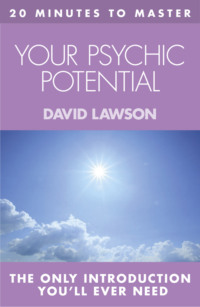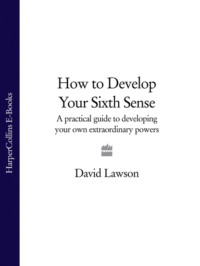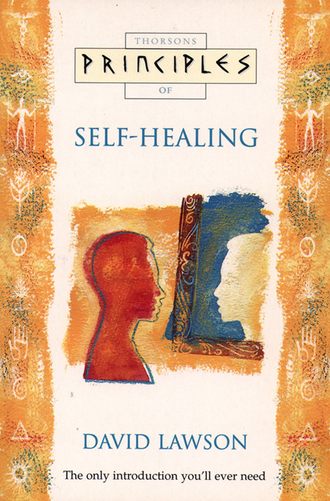
Полная версия
Self-Healing: The only introduction you’ll ever need

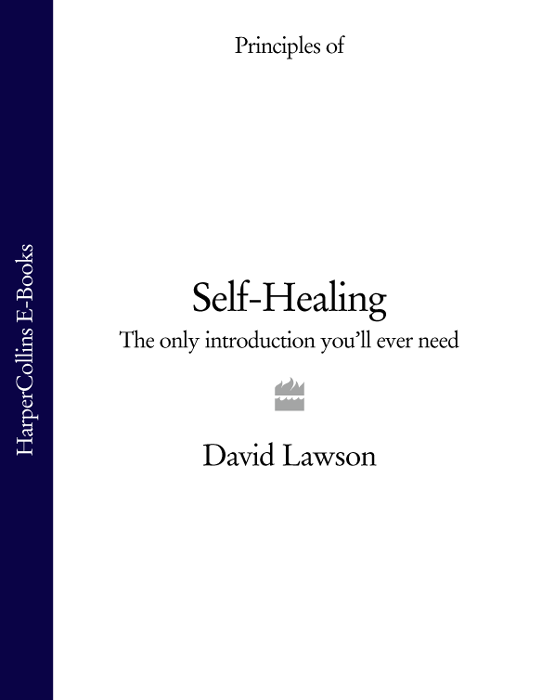

SELF-HEALING
DAVID LAWSON

DEDICATION
THIS BOOK IS DEDICATED TO MY PARENTS
LILIAN AND ERIC, WHOSE CARE AND SUPPORT
HAVE ALWAYS BEEN THERE FOR ME.
WITH LOVE, DAVID
CONTENTS
Cover
Title Page
Dedication
A Personal Note by Justin Carson
1 Beginning the Journey
2 Healing your Mind
3 Your Positive Potential
4 The Intelligence of your Body
5 The Wisdom of your Emotions
6 Living in the Present
7 Your Spiritual Journey
Golden Light – I Forgive
Index
Acknowledgements
About the Author
Praise
In the Same Series
Also by the Author
Copyright
About the Publisher
A PERSONAL NOTE BY JUSTIN CARSON
‘Healing’ is not something that can be ‘done’ to us, it requires our active participation in changing our thoughts, changing our old emotional patterns and ultimately changing our circumstances so that we can engender a healthier state of being.
This is an exceptional book in the field of ‘self-healing’ in that it doesn’t eschew tried and tested medical techniques. We are, however, asked to learn how to balance the advice and knowledge of medical and complementary practitioners with our own innate healing skills. In doing so we can change the patterns in our lives that have helped to create our problems and ailments in the first place.
Reading this book will furnish you with all the tools that you need to start changing the ingrained mental and emotional patterns that you have learned from early childhood. Applying these techniques will help you emerge as a healthier and more empowered person.
‘Healing’ is also about quality of life. Not everyone will get well again, but we can all learn to live with honour, dignity and courage, whatever the future holds. While self-healing is primarily concerned with extending and celebrating life, for some, the process of dying can produce the greatest healing of all.
David Lawson is a warm and skilful healer; everyone who comes into contact with him departs recharged and invigorated by his kindness, skill and words of wisdom.
I trust that you will enjoy this book as much as I have and that it will benefit you in countless, and as yet unimaginable, ways.
JUSTIN CARSON
HEALER AND COURSE LEADER
1 BEGINNING THE JOURNEY
THE ADVENTURE OF HEALING
Self-healing is an ongoing adventure, a voyage of self-discovery where each of us has the opportunity to explore a multitude of choices and solutions to our ever-changing needs. Whether we begin our journey completely healthy or in the midst of dealing with a physical illness, mental problem or emotional need, there is much to discover and to put into practice that will enhance our lives in ways that go beyond our wildest dreams. Our ticket as we embark upon this adventure is a desire to learn and grow, our passport a willingness to change our lives for the better.
Your desire may already be clear to you. Perhaps you wish to stay healthy and prevent the onset of illness, disease or disharmony. Perhaps you are looking for support in dealing with an existing health problem and making the most of the medical or complementary therapies that you are encountering along the way.
For some of you reading this book, your need or desire may be less specific. Perhaps you wish to exorcise some ghosts from your past or create a greater sense of wholeness, inner peace, confidence, self-esteem and forward direction. In some cases you may wish to build on the foundation of well-being and happiness that you already have in your life, to discover more joy, more freedom and greater opportunities for fulfilment.

This book explores the principles of self-healing; these principles can be adapted to help you with any aspect of life-enhancement or personal development. The principles that underpin any exercise that focuses on physical healing can equally be directed to helping with emotional, mental or spiritual needs. Please use the ideas and techniques that are appropriate for you and be creative in adapting them for your own special requirements.
WHAT IS SELF-HEALING?
Self-healing is a continual process of taking charge of your health, well-being and personal potential. It comes from actively seeking solutions to the many challenges that we face in our lives rather than seeing ourselves as victims of fate. Instead of doing our best to negotiate a route through the ups and downs of our existence we can make a decision to create the life that we desire and to live it to the best of our ability.
• Self-healing is using the powers of your mind positively and constructively. To heal and develop your life, you need to be willing to discard the old thoughts, beliefs and attitudes that no longer support you in health and harmony, and exchange them for new ones that do.
• Self-healing is listening to the intelligence and wisdom of your body. You need to be aware of your physical needs and you need to take action to exercise, feed and think about your body in ways that are loving and healthy.
• Self-healing is harnessing the creative, positive energy of your emotions. You need to be willing to listen to your heart, acknowledge your feelings and express them safely and effectively.
• Self-healing is also about finding your place in the greater scheme of things and developing a philosophy or a spiritual awareness that gives your life a sense of meaning. You need to be willing to expand your view of the world and entertain the joyful mysteries of the universe, regardless of your background, culture or the beliefs that you were brought up with.
This book is a guide to the powers of your mind and your ability to make new choices that will allow mental, emotional, physical and spiritual changes to occur in your life. It is for you to decide to act upon those choices, but each little step forward, no matter how small, can be a giant leap towards self-healing and personal development.
HOW CAN WE STAY HEALTHY?
Very simply, we stay healthy when we remain in balance. It helps to be in balance with other people and with our environment, but the most important place to start is with ourselves. To be in harmony with the world around us it is often best to begin by creating harmony within and then work outwards. To have our lives in balance we need to balance ourselves physically, mentally, emotionally and spiritually.
Finding balance is not about sticking to a rigid formula. It is not a case of learning how to do all the right things and holding it there. For example, if you were shown how to place your body in perfect physical alignment so that your posture was 100 per cent correct, you would have been done a great service. If, however, you were encouraged to hold yourself rigidly in one correct position so that you would never lose that perfect alignment, you would have been done a great disservice. Life is about constant change and movement; being balanced is never going to look quite the same twice.
As we progress through the ideas and techniques that I am sharing here with you I will be encouraging you to remember and use the four key principles of self-healing: to listen, to notice, to choose and to adapt.
LISTENING
Some of us are born with good listening skills; some of us learn them from our parents or parent figures; some of us learn by necessity later on in life. Are you a good listener? However good you are there is always something new that you can learn about listening.
Listening is not dependent on our ability to hear. People with impaired hearing can sometimes be better at listening than people whose hearing is clear and perfect.
To heal ourselves we need to listen to our feelings, listen to our bodies, listen to the words that we use, listen to the sound of or feel the vibration of our voices, listen to the information that is coming to us from other people and from our environment. When we listen, we are blessed with all the information that we need to make wonderful healing changes in our lives.
NOTICING
When we notice something it often takes on a power or a significance that it did not previously have. When we notice a beautiful flower, a wonderful fragrance or a captivating sound our mood may change; thoughts, memories or associations may come to mind that were not present before. Similarly, if we notice something unpleasant then it may also take on a significance for us and affect our mood – but by noticing it we can make a choice to change it or, alternatively, to change our response to it.
To heal ourselves we need to be willing to notice our thoughts and beliefs, notice what motivates us and gives us energy, notice what de-motivates us and depletes our energy. It helps to notice the images, inspirations and insights that we receive. Noticing gives us power and helps us to take positive action.
CHOOSING
So many of us put up with the unsatisfactory or unhealthy elements of our lives because we do not realize that we have the power of choice. We tend to believe that life is something that happens to us regardless of our wishes, dreams or desires, and we often picture ourselves as victims of circumstance doing our best to cope with the hand that we have been dealt.
When we learn that we have a choice and that we have a right to exercise that choice in all areas of our health and happiness, we discover that we have the power to make wonderful changes.
To heal ourselves we often need to choose new ways of thinking and acting. This includes choosing new ways to look at life, choosing to let go of anything that no longer supports our health and happiness and choosing new directions that will enhance our personal development. When we exercise our choice we create new options for ourselves and we take charge of our destiny.
ADAPTING
Some illnesses and many problems are created as a direct result of our basic fear of and resistance to life. Even the most positive, go-ahead people may fear or resist some areas of change. In contrast, some of the healthiest people I have met have been those with a great willingness to adapt and learn new ways of approaching life.
To heal ourselves we often need to adapt to changing circumstances: adapting to different environments, adapting to changing needs and desires, adapting our approach to obtain the best results in all situations, adapting ideas, techniques, treatments and philosophies. When we are willing to adapt we remain flexible and open to solutions that go beyond our previous expectations or experience.
When we continue to listen, notice, choose and adapt then we are able to create and re-create balance within ourselves, allowing our passage through life to be as healthy and happy as it was always meant to be. This is particularly important when we need to respond to the message of illness.
THE MESSAGE OF ILLNESS
While it is always preferable to stay balanced and prevent illness from occurring as much as possible, the advent of illness can be a gift, especially when we choose to look at our situation positively and with love. It is true that we may not feel that our illness is a blessing when it is painful or uncomfortable and when it inhibits us from living life to the full, but we still have it within our power to turn it into a beneficial gift rather than a curse.
Illness always brings a message. Physical symptoms tell us that there is something we need to learn about ourselves and something we need to change. The message may be a predominantly physical one. If we have a backache then the message might be that we need to learn to move in a different way or that we need to learn to stand correctly. Listening to your body and noticing aches and pains early on can allow you to choose new ways of correcting them by finding out about, for example, appropriate exercise, therapies and postural training. Even if you begin to take heed of the aches after some damage has already occurred, there is much you can do to improve the situation and prevent further deterioration.
With physical symptoms, however, the message may also be emotional. The backache that requires us to move, lift and stand in a healthier way can also require us to look at the cause of the emotional tension that is contributing to the pain or discomfort we are experiencing.
Alternatively, the message may be a mental one: perhaps we are viewing ourselves and our lives in ways that rigidly adhere to old patterns of belief that no longer suit us. Rigid thinking is one cause of rigidity within the body; the pain may be telling us that we need to change the way that we view our current situation.
Physical symptoms all tell us that there is something that we need to know and, in many cases, something that we need to do to heal our lives. It is similar with emotional problems, accidents, break-downs of communication, challenging relationships and periods of crisis or disturbance. Everything contains a message and everything is a gift if we remain open and willing to use it as one.
THE HEAD, THE HEART AND THE VOICE
Many natural healing traditions work by aligning the head, the heart and the voice. Native American and other indigenous cultures from around the world have systems of healing that are passed down from generation to generation. They include the use of natural medicines, sacred rituals and an understanding of human nature that so-called civilized cultures are having to relearn. An essential understanding of human nature includes the knowledge that when the head, the heart and the voice are in conflict then there will be an imbalance, and disease or disharmony will follow.
The head is, of course, our unique collection of thoughts, beliefs attitudes, judgements and opinions; the heart is our wealth of feelings, emotions, instincts and physical sensations; the voice is our expression, our communication and our creativity. The modern world places a strong emphasis on the head. We live at a time when the pace is generally getting faster and the technology that we are using makes it necessary for us to update and expand our knowledge constantly. Our educational systems are more concerned with the acquisition of facts than they are with teaching us to express ourselves properly and to be in touch with our feelings and intuition.
It is true that the numerous advances in technology, science and human knowledge are miraculous gifts. If used with wisdom and awareness they can transform many areas of our lives for the better – but we need to keep ourselves balanced in order to develop that wisdom. For each of us individually, keeping our heads, hearts and voices in alignment is the best way that we can negotiate and transcend the stresses of modern living.
SUZANNE’S STORY
Suzanne was a woman with a very passionate, expressive nature whose instincts compelled her to respond to life with emotion, compassion and sensitivity. When she first came to me for a healing and counselling session she was feeling stuck and frustrated. Nothing seemed to be working for her in her career or personal life and she had regular periods of depression. Sometimes her depressions would last for weeks; she described them as being marooned from life as if she were living on some colourless desert island, disconnected from the rest of the world.
Experiences like this can be very common. Many of us have felt cut off from other people or cut off from ourselves. Listening to this sensitive person talk about her life I became aware that I could hear different messages coming from different parts of her being. I shared the idea with Suzanne that we all need to have our heads, our hearts and our voices in alignment, and asked her to tell me what she was feeling in her heart.
Suzanne told me how she was often easily moved to tears – anything from a beautiful piece of music to the simplest gesture of love would bring tears of joy, sadness and release. She also told me that during her periods of depression she sometimes lost her ability to feel anything and that would distress her. At times she would have the pain of emotion sticking in her throat. Indeed, she regularly suffered from a sore throat and occasionally lost her voice completely.
I asked her what she thought about her emotions and Suzanne told me that she loved to have them but that she was afraid that they might be a bad thing. She thought that it was not healthy to be too emotional. When she was a little girl Suzanne’s father had told her off for being ‘too sensitive’. He had told her that she ought to control her emotions because to do otherwise left her open to being taken advantage of by other people. He had given her the idea that to be strong and self-reliant meant hiding her sensitivity away from the world.
Suzanne’s heart was filled with positive, emotional energy but her head was filled with many limiting beliefs and judgements about expressing her emotion. The result was that Suzanne’s voice was confused: sometimes it expressed the feelings that were present and sometimes it choked them back, literally, and that was when Suzanne became sick or depressed. The colour and inspiration of Suzanne’s life were all tied up in her emotional nature, and it was through her feelings that she had the most valuable contact with other people and with the world around her. It is no surprise that she felt marooned on a colourless island when she felt restrained from expressing herself.
The more that Suzanne let go of her judgements and allowed herself to be sensitive and passionate, the more joyful she felt, the less depressed she was and the more her life worked for her. She learned to think and speak in ways that expressed her true nature, and her head, her heart and her voice moved into alignment. It is interesting to note that when she gave herself full permission to be emotional she discovered that she did not always need to be. What is more, she learned to feel strong and safe whether she was emotional or not.
THOUGHTS, FEELINGS AND EXPRESSION
For many of us the conflict between the feelings or desires of our hearts and the beliefs and judgements that we hold in our heads can create stress in our bodies that manifests as physical illness or repetitive problems whether in our relationships, our careers or our financial security. Our voices are left confused, expressing mixed messages or, in some cases, very little at all. We do not say what we mean, nor do we truly mean what we say.
If, for example, we feel very angry because someone we love has abused or disregarded us in some way but we hold a belief that we do not have the right to be angry, we may find ourselves expressing anger in indirect ways such as by whining, moaning, being sarcastic or blaming ourselves for our predicament. Sooner or later that tension will create an illness inside us or adversely affect our ability to communicate properly with other people.
The good news is that we always have a choice to change this kind of damaging pattern, trading in unhealthy beliefs for healthy ones and releasing destructive forms of communication in favour of the kind of expression that will bring us positive results. In this way we can always help ourselves to stay in good health.
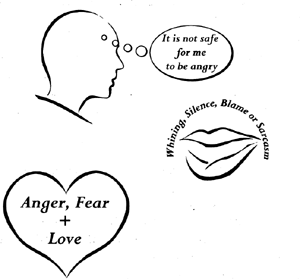
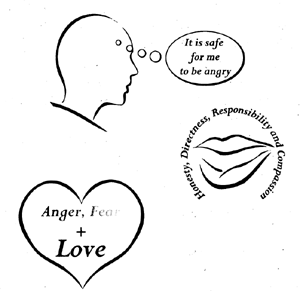
By changing our negative, limiting or judgemental beliefs into positive, accepting, permissive ones we support our feelings, needs and desires, discovering healthy, loving ways to express them. By developing the belief that it is safe for us to express our anger, we can be honest with the people around us, seek new solutions to conflicts of interest and leave ourselves free to express more of the love that we have in our hearts. Love is often trapped and obscured by anger or fear that we feel unable to express and let go of.
Exercise: Aligning the Head, the Heart and the Voice
For this exercise you will need 20 minutes of peace and quiet, somewhere comfortable to sit, and a pen and paper.
Start by sitting quietly and breathing deeply, consciously slowing down your breath a little so that you become settled and calm.
Next, think about one specific health issue that you have, or something else that is challenging you at the moment. It could be a problem with a relationship or some aspect of your work that is frustrating you.
Focus first on your heart. Take a few moments to ask yourself the question ‘What do I feel about this in my heart?’ If it helps, you could place your hand on your chest and imagine that, as you breathe, you breathe directly into your heart and the feelings that you have inside you.
Do you feel sad?
Do you feel angry?
Do you feel joyful? confused? numb? disappointed? hurt? passionate? excited? scared?
Do you have desires or needs pulsing away in your heart that need to be acknowledged and expressed?
Listen to your feelings and notice them.
Next, focus on your head. Ask yourself the question ‘What do I think about this?’ As you breathe, imagine that you are able to shine a light on to your thoughts and beliefs to make them more visible. Ask yourself:
‘What do I think about this health issue, challenge or problem?’
‘What do I think about my feelings?’
‘Is it safe for me to feel like this?’
‘Do I have judgements about my feelings?
‘Do I have negative or limiting thoughts about this situation?’
Listen to your thoughts and beliefs and notice them.
Take a few moments to write down what you feel and think.
Now focus on your voice. Placing a hand gently on your throat, ask yourself ‘What do I need to say about this?’ As you breathe, imagine your throat relaxing and ask yourself:
‘Do I need to express my feelings?’
‘Do I need to ask for help?’
‘Do I need to communicate my desires or requirements?’




